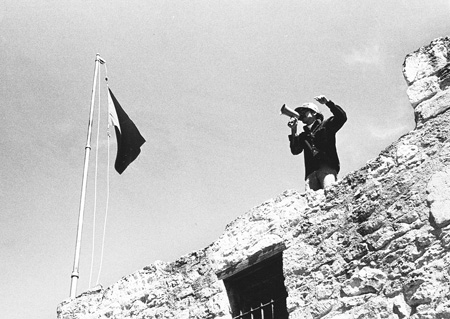
Damián Garcia with hammer and sickle flag atop the Alamo in San Antonio, Texas, March 20, 1980.
Who Was Damián?
Damián Garcia was an undergraduate student at UCSB from 1967 to 1971, and graduated with a degree in Cultural Anthropology. Born into a working-class family, Damián spent his youth in San Bernardino. Driven by a commitment to serving the poor, Damián was involved in student and community organizing at UCSB and surrounding communities. Active in promoting social change, Damián served as Acting Executive Director of La Casa de La Raza after graduating from UCSB. This grassroots community center was founded in 1971 by a group of community activists, and Damian's activities and priorities included an individualized and bilingual approach to learning as well as an internationalist perspective.
Frustrated with the ad hoc approach to addressing the needs of immigrants, Latinos, and the poor, Damián gravitated towards political organizations. In the late 1970s he became a member of the Revolutionary Communist Party, USA, moving to Los Angeles and taking a working-class job with others from the Santa Barbara community. As a party member, Damián was instrumental in organizing among immigrant Latinx communities, particularly in US cities. While organizing for the 1980 May Day event at Public Housing Projects in the Boyle Heights neighborhood of Los Angeles, Damián was assaulted by two residents, and was subsequently stabbed to death. With Damián at the time of his death was Fabian Lizarraga, an undercover Los Angeles Police Department Officer who had infiltrated the organization for over a year. Officer Lizarraga had been participating in organizing activities with Damián Garcia, all the while carrying on a sexual relationship with a female member of the RCP. Two months after Damián's murder, the alleged killer was himself stabbed to death. To date, no investigation of Damián's murder, and the murder of his alleged killer, have been undertaken, fueling suspicion that Damián was set up for an assassination.
Raza Revolutionaries & Their Relevance Today
Under the rubric of the multivolume and multimedia special project series—Isla Vista Reformers, Radicals, and Revolutionaries—a team of activists and scholars supported by the Global Latinidades Project have formed an editorial collective to explore the life and continuing legacy of Damián Garcia. This project is part of a broader initiative to document the student and community activist legacy at UCSB and surrounding areas, to include Isla Vista and municipalities and communities in the California Central Coast, from the 1960s to the present. This second volume in the series involves a documentary film and related exhibit, colloquium, research article, and chapter for a book project on the Latinx Left.
Several Fundamental questions guide this project. Why did Damián choose to become a Chicanx communist instead of a Chicanx cultural nationalist like many of his friends at UCSB and surrounding communities? What was communism for Damián and how does his specific synthesis of a collectivist, communal, and egalitarian model of society account for racial, gender, and sexuality stratifications? What points of intersection and divergence emerge between Damián's model of liberation and empowerment vis-a-vis contemporary models and movements? And where does UCSB, Isla Vista, Santa Barbara barrios, and the California Central Coast figure in Damián's transformations?